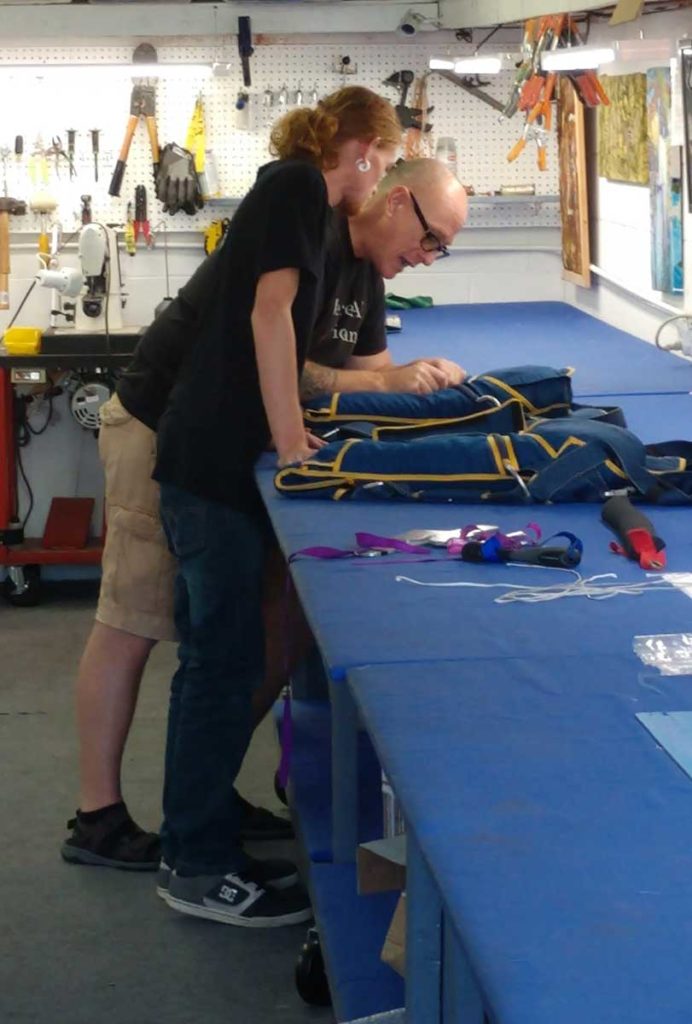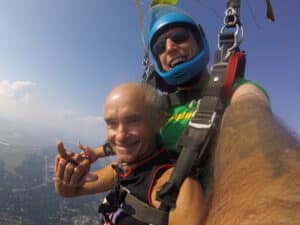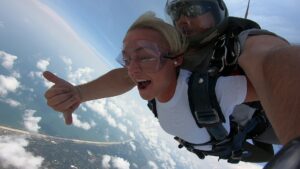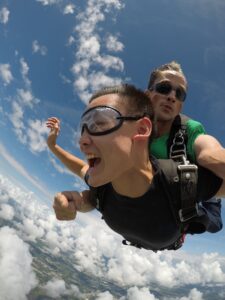Skydiving Training
Skydiving training is a serious issue. While the skies are open to virtually anyone who wants to explore them, you can’t just hop on the first plane you find and jump. Well, I suppose you could but that probably shouldn’t be your first choice of a skydiving center! No, for an experience that is memorable as well as safe, you are going to want some skydiving training.
What is there to learn about skydiving training? While it’s not the most complicated set of rules to play by, it isn’t as simple as jump, open, land. Those are the beats we want to hit, but there are going to be more steps to reach each milestone in your day.
How to Check Your Skydiving Gear
Ah, the moment of truth – gearing up for a skydive! It’s like a fashion show, but instead of haute couture, you’re donning the latest in “not plummeting to Earth” chic. You’ll be given a crash course (pun absolutely intended) on the ensemble of safety. Helmets so snug they could double as a second skull, harnesses that embrace you tighter than your grandma at Christmas, and not one, but two parachutes – because who doesn’t love a good backup?
You’ll be inspecting this gear like Sherlock with a magnifying glass. And fear not, eagle-eyed future skydivers, the instructors are on hand to confirm whether that loose thread is just a harmless string or the unraveling of your mortal coil. Spoiler: it’s probably just a string.
And let’s talk fit. If the harness isn’t hugging you like a long-lost friend, then we’ve got a problem. We take your measurements more seriously than a tailor on Savile Row. Because the only thing worse than a free-fall is a free-fall accompanied by an ill-fitting harness and the impending doom of motion sickness. We’re aiming for unforgettable memories, not unforgettable regurgitations.
And for those worried about the camera adding ten pounds, fret not. Our handicams are just as ready for their close-up as you are for yours. So, smile, wave, and remember – it’s not the fall that gets you; it’s the sudden stop at the end. Happy flying!
Skydiving Technique
You can skip rope, jump up into a truck, dive off the high board at the pool — so you can jump out of a plane no problem, right? Yes! And no. Those are all good indicators of being in good health for skydiving, but your technique will likely need some more fine tuning. You will be shown how to tuck in your knees to get the right amount of power on your end. A common way to cover this will include new skydivers practicing their jumps off picnic tables- a fun way to practice without getting up in the air.
It also takes surprising skill to properly freefall. A basic technique common for novice skydivers to learn is tracking. Tracking is the technique that allows the skydiver to freefall horizontally reliant on the position of their body. There are many other techniques you can investigate as your skills develop and you no longer need a tandem instructor. Body positions will affect your ability to steer the parachute, another skill you will be taught in skydiving class.
How to land is another skill you are going to learn. While it may not feel like it, once you open your parachute, you are still traveling around 30mph. It’s a big change from the 120mph during freefall, but still faster than most people have experience outside of a vehicle. When you return from the experience, you’ll be sliding into home like Jose Consaco. Learning the right way to land will minimize the chance of injury. Remember to wear comfortable shoes, too! It’s a sport, so you want the right footwear.
Ideal Skydiving Mentality
The headspace you bring with you to the skydiving center is important. It is not unheard of to be nervous. It’s not even a bad thing to be nervous, but you want to remain positive. That’s why one thing that will be discussed in your skydiving lesson will be others’ stories. Instructors and other students alike share their stories while ensuring you are getting all of the info that you need.
Skydiving is a community as well as a sport. The community factor is a big draw for skydivers because of the positivity that they have found here. Many different paths have led them to the plane, but they are all looking for the same thrill. One of the last things you’ll experience before jumping out of the plane is a community handshake. It’s loud in the plane, and we want everyone to have a safe and fun jump – so this ritual is just as important as the how-tos and techniques.
Tandem skydiving training takes a lot of the work out of skydiving for you if that is what you are looking for. It also allows the more adventurous among us to safely take the reins from their instructor and really control the experience. This another thing that the lesson will help you figure out — are you looking for an easy ride or do you want to take control of your experience?
Remember, your first skydiving training isn’t going to cover everything you need to be a master of the skies. But it can and will equip you for your first skydive, ensuring you feel comfortable and confident. This is why tandem is also a great first experience. If you do happen to forget a step, your instructor is there to remind you. A bonus to the handicam footage we offer is that you can revisit this first jump over and over. You can rewatch and see what steps you remembered in the moment. If you become a skydiver it will be helpful to see where you can improve, and you’ll treasure watching those possible mistakes when you are an expert.
We are experts in safety and skydive training want you to be too. By the time you are 12,000ft up you will be equipped and knowledgeable, ready to educate your less adventurous friends on what they are missing. If you would like to book a once in a lifetime experience, contact us. Our customer service professionals are ready to answer your questions and to find the best flight day that works for you.






